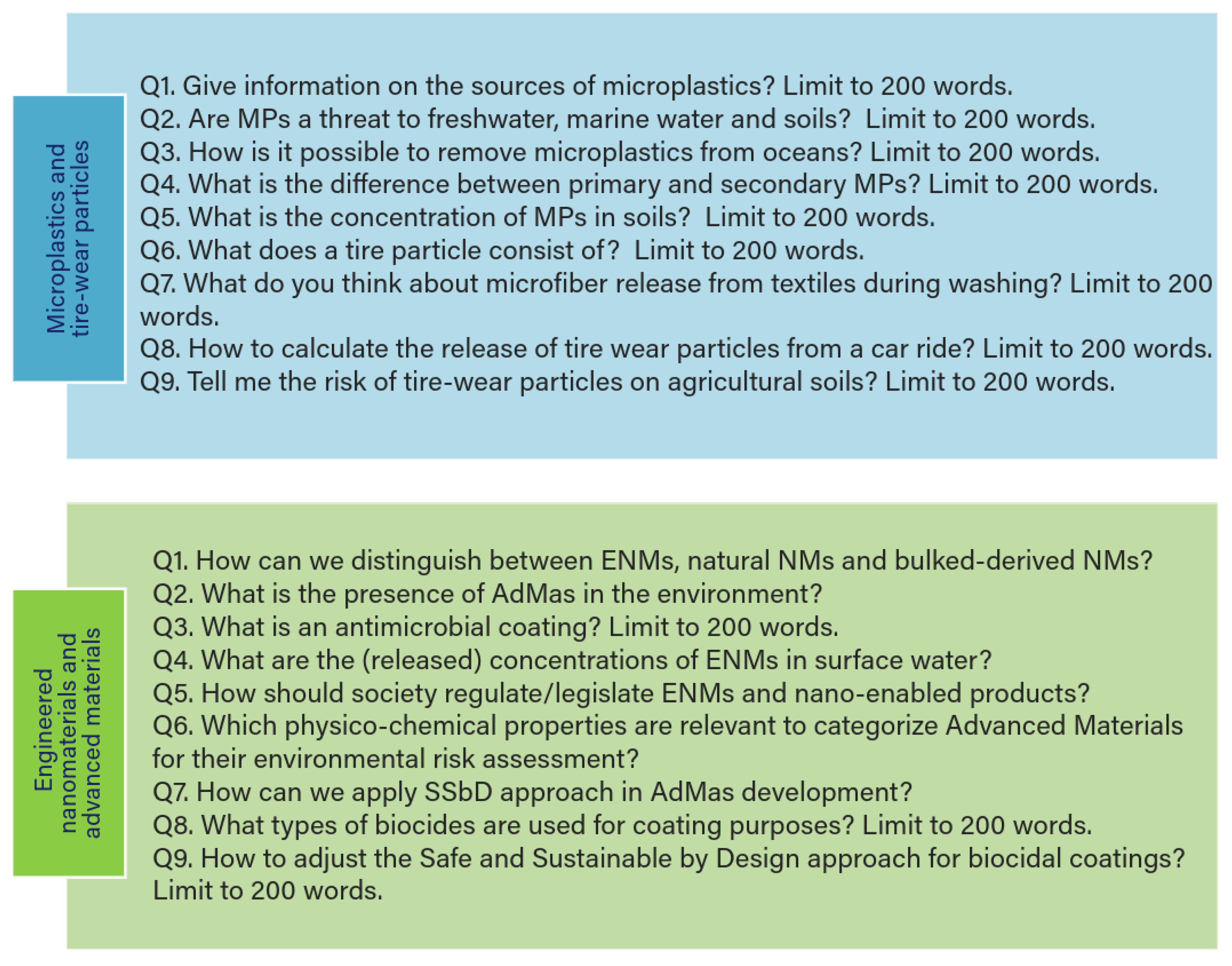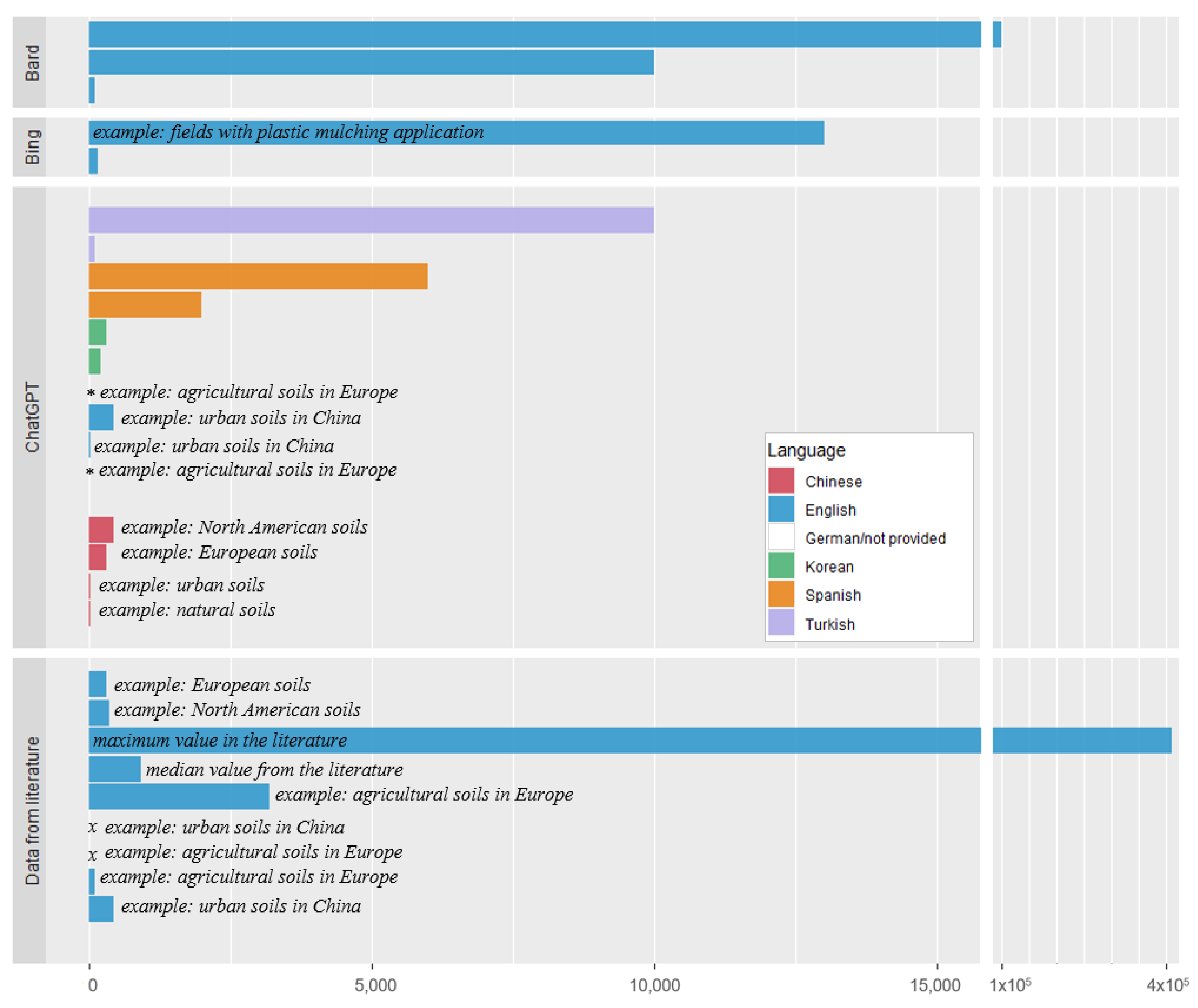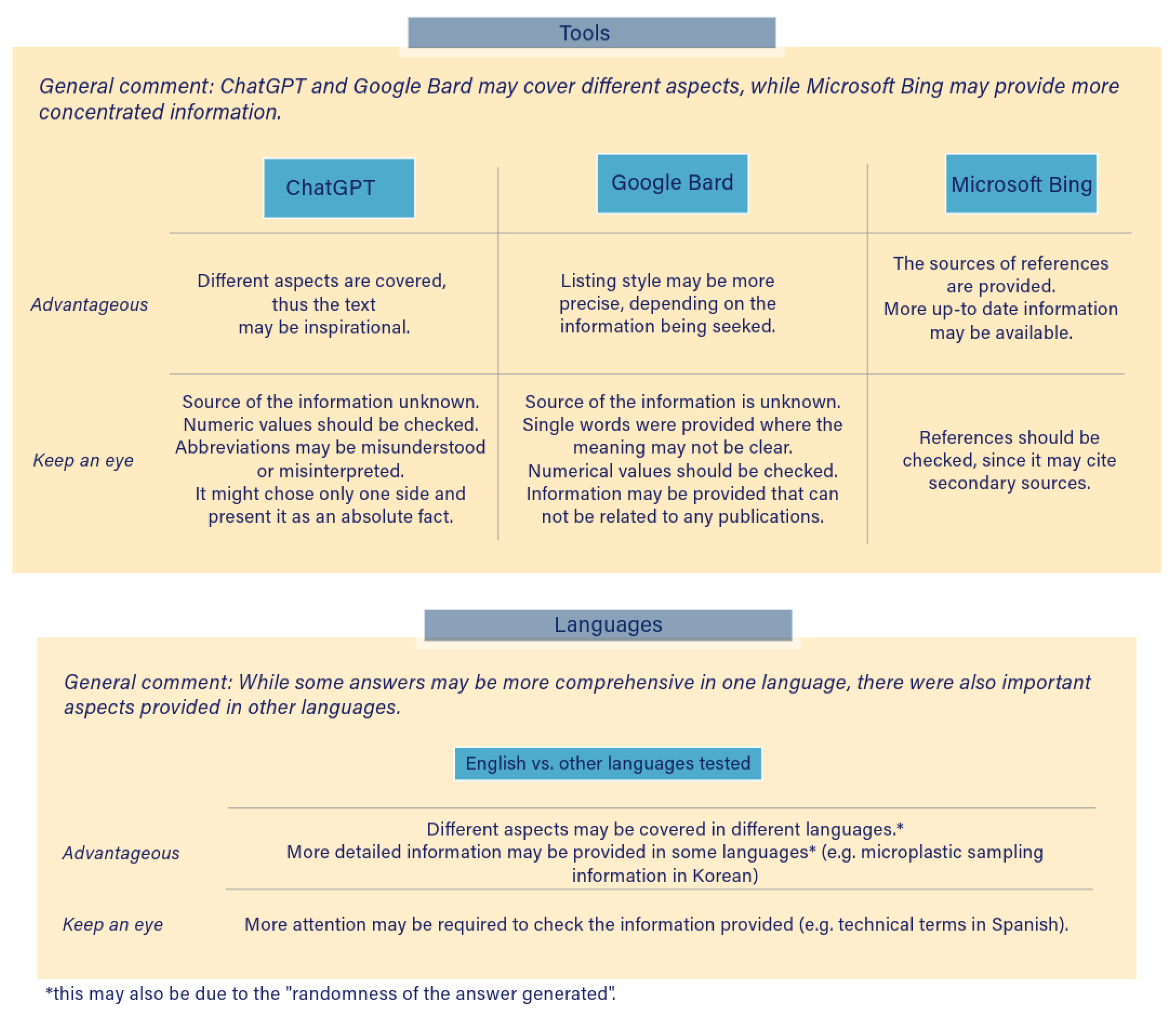Conversational AI Tools for Environmental Topics: A Comparative Analysis of Different Tools and Languages for Microplastics, Tire Wear Particles, Engineered Nanoparticles and Advanced Materials
Abstract
:1. Introduction
2. Methodology
3. Results and Discussion
3.1. Content Quality
3.1.1. Microplastics
3.1.2. Engineered Nanomaterials and Advanced Materials
3.2. Differences Observed When Using Different Conversational AI Tools
3.3. Differences Observed When Using Different Languages
4. Conclusions
Supplementary Materials
Author Contributions
Funding
Institutional Review Board Statement
Informed Consent Statement
Data Availability Statement
Conflicts of Interest
References
- Kasneci, E.; Sessler, K.; Küchemann, S.; Bannert, M.; Dementieva, D.; Fischer, F.; Gasser, U.; Groh, G.; Günnemann, S.; Hüllermeier, E.; et al. ChatGPT for good? On opportunities and challenges of large language models for education. Learn. Individ. Differ. 2023, 103, 102274. [Google Scholar] [CrossRef]
- Snoswell, C.L.; Snoswell, A.J.; Kelly, J.T.; Caffery, L.J.; Smith, A.C. Artificial intelligence: Augmenting telehealth with large language models. J. Telemed. Telecare 2023. [Google Scholar] [CrossRef] [PubMed]
- van Dis, E.A.M.; Bollen, J.; Zuidema, W.; van Rooij, R.; Bockting, C.L. ChatGPT: Five priorities for research. Nature 2023, 614, 224–226. [Google Scholar] [CrossRef] [PubMed]
- OECD. AI Language Models Technological, Socio-Economic and Policy Considerations. OECD 2023, 352, 1. Available online: https://www.oecd-ilibrary.org/docserver/13d38f92-en.pdf?expires=1685070814&id=id&accname=guest&checksum=10A046E2D91F9EF00E484FF8043C59E0 (accessed on 10 July 2023).
- Sabzalieva, E.; Valentini, A. ChatGPT and Artificial Intelligence in Higher Education Quick Start Guide, United Nations Educational, Scientific and Cultural Organization. 2023. Available online: https://www.iesalc.unesco.org/wp-content/uploads/2023/04/ChatGPT-and-Artificial-Intelligence-in-higher-education-Quick-Start-guide_EN_FINAL.pdf (accessed on 15 July 2023).
- Rillig, M.C.; Ågerstrand, M.; Bi, M.; Gould, K.A.; Sauerland, U. Risks and Benefits of Large Language Models for the Environment. Environ. Sci. Technol. 2023, 57, 3464–3466. [Google Scholar] [CrossRef] [PubMed]
- Zhu, J.J.; Jiang, J.; Yang, M.; Ren, Z.J. ChatGPT and Environmental Research. Environ. Sci. Technol. 2023. [Google Scholar] [CrossRef]
- De Souza Machado, A.A.; Lau, C.W.; Kloas, W.; Bergmann, J.; Bachelier, J.B.; Faltin, E.; Becker, R.; Görlich, A.S.; Rillig, M.C. Microplastics Can Change Soil Properties and Affect Plant Performance. Environ. Sci. Technol. 2019, 53, 6044–6052. [Google Scholar] [CrossRef]
- Lozano, Y.M.; Lehnert, T.; Linck, L.T.; Lehmann, A.; Rillig, M.C. Microplastic Shape, Polymer Type, and Concentration Affect Soil Properties and Plant Biomass. Front. Plant Sci. 2021, 12, 616645. [Google Scholar] [CrossRef]
- Kwan, C.S.; Takada, H. Release of Additives and Monomers from Plastic Wastes. In Hazardous Chemicals Associated with Plastics in the Marine Environment. The Handbook of Environmental Chemistry; Takada, H., Karapanagioti, H., Eds.; Springer: Cham, Switzerland, 2017; Volume 78. [Google Scholar] [CrossRef]
- Bridson, J.H.; Abbel, R.; Smith, D.A.; Northcott, G.L.; Gaw, S. Release of additives and non-intentionally added substances from microplastics under environmentally relevant conditions. Environ. Adv. 2023, 12, 100359. [Google Scholar] [CrossRef]
- Gkoutselis, G.; Rohrbach, S.; Harjes, J.; Obst, M.; Brachmann, A.; Horn, M.A.; Rambold, G. Microplastics accumulate fungal pathogens in terrestrial ecosystems. Sci. Rep. 2021, 11, 13214. [Google Scholar] [CrossRef]
- Lv, W.; Zhou, W.; Lu, S.; Huang, W.; Yuan, Q.; Tian, M.; Lv, W.; He, D. Microplastic pollution in rice-fish co-culture system: A report of three farmland stations in Shanghai, China. Sci. Total Environ. 2019, 652, 1209–1218. [Google Scholar] [CrossRef] [PubMed]
- Duan, Z.; Zhao, S.; Zhao, L.; Duan, X.; Xie, S.; Zhang, H.; Liu, Y.; Peng, Y.; Liu, C.; Wang, L. Microplastics in Yellow River Delta wetland: Occurrence, characteristics, human influences, and marker. Environ. Pollut. 2020, 258, 113232. [Google Scholar] [CrossRef] [PubMed]
- Huang, Y.; Liu, Q.; Jia, W.; Yan, C.; Wang, J. Agricultural plastic mulching as a source of microplastics in the terrestrial environment. Environ. Pollut. 2020, 260, 114096. [Google Scholar] [CrossRef] [PubMed]
- Li, B.; Song, W.; Cheng, Y.; Zhang, K.; Tian, H.; Du, Z.; Wang, J.; Wang, J.; Zhang, W.; Zhu, L. Ecotoxicological effects of different size ranges of industrial-grade polyethylene and polypropylene microplastics on earthworms Eisenia fetida. Sci. Total Environ. 2021, 783, 147007. [Google Scholar] [CrossRef]
- Tunali, M.; Adam, V.; Nowack, B. Probabilistic environmental risk assessment of microplastics in soils. Geoderma 2023, 430, 116315. [Google Scholar] [CrossRef]
- Chai, B.; Wei, Q.; She, Y.; Lu, G.; Dang, Z.; Yin, H. Soil microplastic pollution in an e-waste dismantling zone of China. Waste Manag. 2020, 118, 291–301. [Google Scholar] [CrossRef] [PubMed]
- Scheurer, M.; Bigalke, M. Microplastics in Swiss Floodplain Soils. Environ. Sci. Technol. 2018, 52, 3591–3598. [Google Scholar] [CrossRef]
- Zhou, Y.; Liu, X.; Wang, J. Characterization of microplastics and the association of heavy metals with microplastics in suburban soil of central China. Sci. Total Environ. 2019, 694, 133798. [Google Scholar] [CrossRef]
- Chen, Y.; Leng, Y.; Liu, X.; Wang, J. Microplastic pollution in vegetable farmlands of suburb Wuhan, central China. Environ. Pollut. 2020, 257, 113449. [Google Scholar] [CrossRef]
- Han, X.; Lu, X.; Vogt, R.D. An optimized density-based approach for extracting microplastics from soil and sediment samples. Environ. Pollut. 2019, 254, 113009. [Google Scholar] [CrossRef]
- Harms, I.K.; Diekötter, T.; Troegel, S.; Lenz, M. Amount, distribution and composition of large microplastics in typical agricultural soils in Northern Germany. Sci. Total Environ. 2021, 758, 143615. [Google Scholar] [CrossRef] [PubMed]
- Beriot, N.; Peek, J.; Zornoza, R.; Geissen, V.; Huerta Lwanga, E. Low density-microplastics detected in sheep faeces and soil: A case study from the intensive vegetable farming in Southeast Spain. Sci. Total Environ. 2021, 755, 142653. [Google Scholar] [CrossRef] [PubMed]
- van Schothorst, B.; Beriot, N.; Huerta Lwanga, E.; Geissen, V. Sources of light density microplastic related to two agricultural practices: The use of compost and plastic mulch. Environments 2021, 8, 36. [Google Scholar] [CrossRef]
- Isari, E.A.; Papaioannou, D.; Kalavrouziotis, I.K.; Karapanagioti, H.K. Microplastics in agricultural soils: A case study in cultivation of watermelons and canning tomatoes. Water 2021, 13, 2168. [Google Scholar] [CrossRef]
- Delre, A.; Goudriaan, M.; Morales, V.H.; Vaksmaa, A.; Ndhlovu, R.T.; Baas, M.; Keijzer, E.; de Groot, T.; Zeghal, E.; Egger, M.; et al. Plastic photodegradation under simulated marine conditions. Mar. Pollut. Bull. 2023, 187, 114544. [Google Scholar] [CrossRef]
- De Falco, F.; Gullo, M.P.; Gentile, G.; Di Pace, E.; Cocca, M.; Gelabert, L.; Brouta-Agnésa, M.; Rovira, A.; Escudero, R.; Villalba, R.; et al. Evaluation of microplastic release caused by textile washing processes of synthetic fabrics. Environ. Pollut. 2018, 236, 916–925. [Google Scholar] [CrossRef]
- Chiweshe, A.; Crews, P.C. Influence of household fabric softeners and laundry enzymes on pilling and breaking strength. Text. Chem. Color. Am. Dyest. Report. 2000, 32, 41–47. [Google Scholar]
- Hernandez, E.; Nowack, B.; Mitrano, D.M. Polyester Textiles as a Source of Microplastics from Households: A Mechanistic Study to Understand Microfiber Release during Washing. Environ. Sci. Technol. 2017, 51, 7036–7046. [Google Scholar] [CrossRef]
- Wang, C.; Chen, W.; Zhao, H.; Tang, J.; Li, G.; Zhou, Q.; Sun, J.; Xing, B. Microplastic Fiber Release by Laundry: A Comparative Study of Hand-Washing and Machine-Washing. ACS ES T Water 2023, 3, 147–155. [Google Scholar] [CrossRef]
- Agathokleous, E.; Rillig, M.C.; Peñuelas, J.; Yu, Z. One hundred important questions facing plant science derived using a large language model. Trends Plant Sci. 2023, in press. [Google Scholar] [CrossRef]
- Gottschalk, F.; Sun, T.; Nowack, B. Environmental concentrations of engineered nanomaterials: Review of modeling and analytical studies. Environ. Pollut. 2013, 181, 287–300. [Google Scholar] [CrossRef]
- Hochella, M.F.; Mogk, D.W.; Ranville, J.; Allen, I.C.; Luther, G.W.; Marr, L.C.; McGrail, B.P.; Murayama, M.; Qafoku, N.P.; Rosso, K.M.; et al. Natural, incidental, and engineered nanomaterials and their impacts on the Earth system. Science 2019, 363. [Google Scholar] [CrossRef] [PubMed]
- Wigger, H.; Kägi, R.; Wiesner, M.; Nowack, B. Exposure and Possible Risks of Engineered Nanomaterials in the Environment—Current Knowledge and Directions for the Future. Rev. Geophys. 2020, 58, e2020RG000710. [Google Scholar] [CrossRef]
- Wagner, S.; Gondikas, A.; Neubauer, E.; Hofmann, T.; Von Der Kammer, F. Spot the difference: Engineered and natural nanoparticles in the environment-release, behavior, and fate. Angew. Chem.-Int. Ed. 2014, 53, 12398–12419. [Google Scholar] [CrossRef]
- Cipta, I.; Febiyanto, F.; Syoufian, A.; Kartini, I. Identification and Characterization of Nanoclays in Gamalama Volcanic Soil of Northern Maluku. Clays Clay Miner. 2022, 70, 438–449. [Google Scholar] [CrossRef]
- Nowack, B.; Baalousha, M.; Bornhöft, N.; Chaudhry, Q.; Cornelis, G.; Cotterill, J.; Gondikas, A.; Hassellöv, M.; Lead, J.; Mitrano, D.M.; et al. Progress towards the validation of modeled environmental concentrations of engineered nanomaterials by analytical measurements. Environ.Sci. Nano 2015, 2, 421–428. [Google Scholar] [CrossRef]
- Suhendra, E.; Chang, C.H.; Hou, W.C.; Hsieh, Y.C. A review on the environmental fate models for predicting the distributionof engineered nanomaterials in surface waters. Int. J. Mol. Sci. 2020, 21, 4554. [Google Scholar] [CrossRef]
- Bouchard, D.; Knightes, C.; Chang, X.; Avant, B. Simulating Multiwalled Carbon Nanotube Transport in Surface Water Systems Using the Water Quality Analysis Simulation Program (WASP). Environ. Sci. Technol. 2017, 51, 11174–11184. [Google Scholar] [CrossRef]
- Keller, A.A.; McFerran, S.; Lazareva, A.; Suh, S. Global life cycle releases of engineered nanomaterials. J. Nanopart. Res. 2013, 15, 1692. [Google Scholar] [CrossRef]
- Han, Y.; Knightes, C.D.; Bouchard, D.; Zepp, R.; Avant, B.; Hsieh, H.S.; Chang, X.; Acrey, B.; Matthew Henderson, W.; Spear, J. Simulating graphene oxide nanomaterial phototransformation and transport in surface water. Environ. Sci. Nano 2019, 6, 180–194. [Google Scholar] [CrossRef]
- Isigonis, P.; Afantitis, A.; Antunes, D.; Bartonova, A.; Beitollahi, A.; Bohmer, N.; Bouman, E.; Chaudhry, Q.; Cimpan, M.R.; Cimpan, E.; et al. Risk Governance of Emerging Technologies Demonstrated in Terms of its Applicability to Nanomaterials. Small 2020, 16, e2003303. [Google Scholar] [CrossRef] [PubMed]
- Renn, O.; Roco, M.C. Nanotechnology and the need for risk governance. J. Nanoparticle Res. 2006, 8, 153–191. [Google Scholar] [CrossRef]
- Malsch, I.; Isigonis, P.; Dusinska, M.; Bouman, E.A. Embedding Ethical Impact Assessment in Nanosafety Decision Support. Small 2020, 16, e2002901. [Google Scholar] [CrossRef] [PubMed]
- Rodríguez, H. Nanotechnology and Risk Governance in the European Union: The Constitution of Safety in Highly Promoted and Contested Innovation Areas. NanoEthics 2018, 12, 5–26. [Google Scholar] [CrossRef]
- Mullins, M.; Himly, M.; Llopis, I.R.; Furxhi, I.; Hofer, S.; Hofstätter, N.; Wick, P.; Romeo, D.; Küehnel, D.; Siivola, K.; et al. (Re)Conceptualizing decision-making tools in a risk governance framework for emerging technologies—The case of nanomaterials. Environ. Syst. Decis. 2023, 43, 3–15. [Google Scholar] [CrossRef]
- Subhan, M.A.; Subhan, T. Safety and Global Regulations for Application of Nanomaterials. In Nanomaterials Recycling; Elsevier: Amsterdam, The Netherlands, 2022; pp. 83–107. [Google Scholar] [CrossRef]
- Saldivar-Tanaka, L. Regulando la nanotecnología. Mundo Nano. Rev. Interdiscip. Nanociencias Nanotecnología 2018, 12, 37–57. [Google Scholar] [CrossRef]
- Saldivar-Tanaka, L. Regulación blanda, normas técnicas y armonización regulatoria internacional, para la nanotecnología. Mundo Nano. Rev. Interdiscip. Nanociencias Nanotecnología 2019, 13, 1e–27e. [Google Scholar] [CrossRef]
- Soltani, A.M.; Pouypouy, H. Standardization and Regulations of Nanotechnology and Recent Government Policies Across the World on Nanomaterials. In Advances in Phytonanotechnology: From Synthesis to Application; Elsevier Inc.: Amsterdam, The Netherlands, 2019. [Google Scholar] [CrossRef]
- Giese, B.; Drapalik, M.; Zajicek, L.; Jepsen, D.; Reihlen, A.; Zimmermann, T. Advanced Materials: Overview of the Field and Screening Criteria for Relevance Assessment UBA Texte. 132/2020. Available online: https://www.umweltbundesamt.de/en/publikationen/advanced-materials-overview-of-the-field-screening (accessed on 10 July 2023).
- Kennedy, A.; Brame, J.; Rycroft, T.; Wood, M.; Zemba, V.; Weiss, C.; Hull, M.; Hill, C.; Geraci, C.; Linkov, I. A Definition and Categorization System for Advanced Materials: The Foundation for Risk-Informed Environmental Health and Safety Testing. Risk Anal. 2019, 39, 1783–1795. [Google Scholar] [CrossRef]
- European Commission, Joint Research Centre; Caldeira, C.; Farcal, R.; Moretti, C.; Mancini, L.; Rauscher, H.; Rasmussen, K.; Riego, J.; Sala, S. Safe and Sustainable Chemicals by Design Chemicals and Materials—Review of Safety and Sustainability Dimensions, Aspects, Methods, Indicators, and Tools; Publications Office of the European Union: Luxembourg, 2022. [Google Scholar] [CrossRef]
- Caldeira, C.; Farcal, R.; Garmendia Aguirre, I.; Mancini, L.; Tosches, D.; Amelio, A.; Rasmussen, K.; Rauscher, H.; Riego Sintes, J.; Sala, S. Safe and Sustainable by Design Chemical and Materials. In Jrc Technical Report; Publications Office of the European Union: Luxembourg, 2022; p. 124. Available online: https://publications.jrc.ec.europa.eu/repository/handle/JRC128591 (accessed on 10 July 2023).
- OpenAI. What Is ChatGPT? Commonly Asked Questions about ChatGPT. 2023. Available online: https://help.openai.com/en/articles/6783457-what-is-chatgpt (accessed on 15 July 2023).
- Mackevica, A.; Revilla, P.; Brinch, A.; Hansen, S.F. Current uses of nanomaterials in biocidal products and treated articles in the EU. Environ.Sci. Nano 2016, 3, 1195–1205. [Google Scholar] [CrossRef]
- Zhang, H.; Huang, Y.; An, S.; Zhu, Z. A Review of Microplastics in Soil: Distribution Within Pedosphere Compartments, Environmental Fate, and Effects. Water Air Soil Pollut. 2022, 233, 380. [Google Scholar] [CrossRef]
- Nizzetto, L.; Futter, M.; Langaas, S. Are Agricultural Soils Dumps for Microplastics of Urban Origin? Environ. Sci. Technol. 2016, 50, 10777–10779. [Google Scholar] [CrossRef] [PubMed]
- Tajwar, M.; Shreya, S.S.; Gazi, M.Y.; Hossain, M.B. Abundance and Distribution of MPs and NPs in Soil: A Global Scenario. In Micro and Nanoplastics in Soil; Maddela, N.R., Reddy, K.V., Ranjit, P., Eds.; Springer International Publishing: Cham, Switzerland, 2023. [Google Scholar] [CrossRef]
- Fuller, S.; Gautam, A. A Procedure for Measuring Microplastics using Pressurized Fluid Extraction. Environ. Sci. Technol. 2016, 50, 5774–5780. [Google Scholar] [CrossRef] [PubMed]
- Baensch-Baltruschat, B.; Kocher, B.; Kochleus, C.; Stock, F.; Reifferscheid, G. Tyre and road wear particles—A calculation of generation, transport and release to water and soil with special regard to German roads. Sci. Total Environ. 2021, 752, 141939. [Google Scholar] [CrossRef] [PubMed]
- Mennekes, D.; Nowack, B. Tire wear particle emissions: Measurement data where are you? Sci. Total Environ. 2022, 830, 154655. [Google Scholar] [CrossRef]
- Crossman, J.; Hurley, R.R.; Futter, M.; Nizzetto, L. Transfer and transport of microplastics from biosolids to agricultural soils and the wider environment. Sci. Total Environ. 2020, 724, 138334. [Google Scholar] [CrossRef]
- Mejía, D. Influencia del Polvo de Neumático en la Tensión Indirecta y Energía de Fractura de las Mezclas Asfálticas Tibias (thesis). 2015. Available online: http://132.248.52.100:8080/xmlui/handle/132.248.52.100/8415 (accessed on 15 July 2023).
- Lai, V.D.; Ngo, N.T.; Veyseh, A.P.B.; Man, H.; Dernoncourt, F.; Bui, T.; Nguyen, T.H. ChatGPT Beyond English: Towards a Comprehensive Evaluation of Large Language Models in Multilingual Learning. arXiv 2023, arXiv:2304.05613. [Google Scholar]



Disclaimer/Publisher’s Note: The statements, opinions and data contained in all publications are solely those of the individual author(s) and contributor(s) and not of MDPI and/or the editor(s). MDPI and/or the editor(s) disclaim responsibility for any injury to people or property resulting from any ideas, methods, instructions or products referred to in the content. |
© 2023 by the authors. Licensee MDPI, Basel, Switzerland. This article is an open access article distributed under the terms and conditions of the Creative Commons Attribution (CC BY) license (https://creativecommons.org/licenses/by/4.0/).
Share and Cite
Tunali, M.; Hong, H.; Ortiz-Galvez, L.M.; Wu, J.; Zhang, Y.; Mennekes, D.; Pinlova, B.; Jiang, D.; Som, C.; Nowack, B. Conversational AI Tools for Environmental Topics: A Comparative Analysis of Different Tools and Languages for Microplastics, Tire Wear Particles, Engineered Nanoparticles and Advanced Materials. Sustainability 2023, 15, 14453. https://doi.org/10.3390/su151914453
Tunali M, Hong H, Ortiz-Galvez LM, Wu J, Zhang Y, Mennekes D, Pinlova B, Jiang D, Som C, Nowack B. Conversational AI Tools for Environmental Topics: A Comparative Analysis of Different Tools and Languages for Microplastics, Tire Wear Particles, Engineered Nanoparticles and Advanced Materials. Sustainability. 2023; 15(19):14453. https://doi.org/10.3390/su151914453
Chicago/Turabian StyleTunali, Merve, Hyunjoo Hong, Luis Mauricio Ortiz-Galvez, Jimeng Wu, Yiwen Zhang, David Mennekes, Barbora Pinlova, Danyang Jiang, Claudia Som, and Bernd Nowack. 2023. "Conversational AI Tools for Environmental Topics: A Comparative Analysis of Different Tools and Languages for Microplastics, Tire Wear Particles, Engineered Nanoparticles and Advanced Materials" Sustainability 15, no. 19: 14453. https://doi.org/10.3390/su151914453
APA StyleTunali, M., Hong, H., Ortiz-Galvez, L. M., Wu, J., Zhang, Y., Mennekes, D., Pinlova, B., Jiang, D., Som, C., & Nowack, B. (2023). Conversational AI Tools for Environmental Topics: A Comparative Analysis of Different Tools and Languages for Microplastics, Tire Wear Particles, Engineered Nanoparticles and Advanced Materials. Sustainability, 15(19), 14453. https://doi.org/10.3390/su151914453





